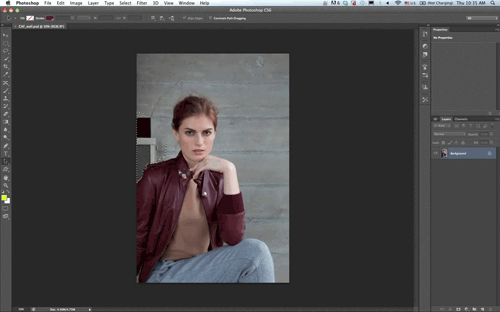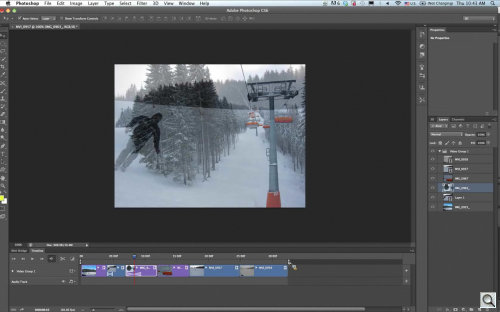BUT AS A PUBLIC BETA
Photoshop CS6 Beta Unveiled

By MIKE PASINI
Editor
The Imaging Resource Digital Photography Newsletter
Review Date: March 2012
In its 22 year existence, Photoshop has never been offered as a public beta. But after the success of the Lightroom public betas, Adobe is releasing Photoshop CS6 beta to the public.
The new version features 62 percent more new features than the previous version, over 64 user-inspired enhancements and the new Adobe Mercury graphics engine to rev up performance, the company told us during a recent briefing. Zorana Gee, Photoshop product manager, said that while the CS5 release was all about converting to a 64-bit architecture and tapping into the GPU pipeline, this release is a much deeper one, focused on features.
Available as a free download from Adobe Labs, the beta period is expected to continue through the first half of the year.
Gee said the beta is based on Photoshop CS6 Extended with features like 3D editing and quantitative image analysis.
SYSTEM REQUIREMENTS | Back to Contents
System requirements have been bumped up a bit with 32-bit support dropped on Mac OS.
Basic requirements include:
- 1-GB RAM
- 2-GB hard disk space
- 1024x768 (1280x800 recommended) display with 16-bit color and 256-MB (512-MB recommended and required for Photoshop Extended) VRAM
- OpenGL 2.0 capable system
- Internet connection and registration (with an Adobe ID) required for software activation
Mac-specific requirements add:
- Multicore Intel processor
- 64-bit support
- Mac OS X v10.6.8 or 10.7
Windows-specific requirements add:
- Intel Premium 4 or AMD Athlon 64 processor
- 32- and 64-bit support
- Microsoft Windows XP with Service Pack 3 or Windows 7 with Service Pack 1
Some GPU-enabled features and 3D features are not supported on Windows XP, Adobe noted. That follows the lead of GPU card manufacturers who are no longer releasing drivers for their newest cards, Gee said.
INSTALLATION | Back to Contents
After downloading, Photoshop CS6 requires a one-time login with an Adobe ID to activate the product, which you can create at that time if you don't have one.
With CS6, Adobe will be associating serial numbers with Adobe IDs rather than the computers the software is installed on. So there's no activation/deactivation dance when you want to move your software to a different machine.
Activation with an Adobe ID will have other benefits, according to the company. Those will include access to Adobe Creative Cloud and the Adobe.com community.
The company said it will also provide a 7-day offline option and contingencies for non-connected customers. According to Adobe, here's how those two scenarios play out:
Regarding the install process at activation, Adobe provides two options depending on whether your computer is temporarily offline or permanently offline:
Temporarily Offline. All CS6 customers will be provided a 7-day grace period after first launch of their product to connect to the Internet.
Permanently Offline. These customers will need to complete an Offline Activation process using an Internet-enabled device, also within seven days of the first launch. But the offline exception process is not supported for beta products.
If you do one offline exception, you have one more machine on which you can install. If you would like to install on two other machines, then you 1) connect the offline machine to the Internet and deactivate the software and 2) install the software on the other two machines using the serial number, either while online or going through the offline process.
Among the highlights of the public beta are:
Mercury Graphics Engine. Mercury was fast, among the gods. And Adobe expects the new graphics engine named after him to maintain the reputation. The company claims tools like Liquify, Puppet Warp, Transform and Lighting Effects now show results in real time without progress bars or lag between brush movement and display of the brush effect. "No tiling," Gee said. "It just happens."
Nvidia's CUDA is not required (or even used) but the more video RAM the better. The engine in Photoshop supports more GPU cards than Premiere.
Adobe Camera Raw 7. The basic tool improvements seen in Lightroom 4, as well as the new imaging engine, are now available in Photoshop with localized corrections improved as well. We found shadow and highlight control to be greatly enhanced in Lightroom 4 and are relieved to see the new engine appear in ACR 7, which can be downloaded from Adobe Labs for use with CS5, too.
Gee showed an iPhone image processed in ACR 7 to bring out shadow detail and highlight color. There are also about double the local corrections you can make.

Camera Raw. Not just for Raw images, Camera Raw here improves an iPhone image.
User Interface Remodeled. The user interface gets a coat of darker paint from the usual neutral gray, although you can select among four different grays. The darker background puts the central focus on the image instead of the user interface, Gee said.
In addition, the user interface police have patrolled the handles, fonts and buttons to enforce a more consistent appearance.
Performance Improvements. You can now save in the background and tap into auto recovery with background save. This makes working with large files more convenient because you don't have to interrupt your work to save a large amount of data.
Rich Cursor Information. You can display more information (like coordinates) along with the cursor now.
Design Enhancements. Vector layers are new so vectors can now have adjustment layers. Dashed or dotted lines are a breeze now, too.
And you can now search layers by kind or attribute, too. Find adjustment layers, type layers, vector layers. You can also search by attribute like visibility (so you can delete all the invisible layers easily).
Photo Enhancements. Customer feedback was "huge" in designing features in this release, Gee said, particularly for image editing. Auto Levels and Auto Curves are "very popular" tools, Gee said, even if most of us don't, uh, admit it. Auto is "much much smarter," she said, analyzing the image according to a database to determine the type of image before optimizing it. Adobe has enhanced both Auto Levels and Auto Curves by skipping per channel optimizations in favor of these database optimizations.
There are also three new blurs: tilt-shift (miniature effect), iris field with a Nik-like interface that lets you set a sharp center for the blur and control the extent of the effect. But you can also add more than one blur effect to an image, which is photographically impossible, Gee pointed out.
Content-Aware Enhancements. Content-Aware technology has been extended to the Patch and Move tools.
With Content-Aware Patch, you can target the area you want Content-Aware Fill to use so it won't pull in extraneous colors or objects.

CA Patch. A patch of wall to the right is used to replace the background behind the woman without picking up any of her jacket.
With Content-Aware Move you can select an object in your image and move it to another part of the image seamlessly. Well, pretty seamlessly. More seamlessly than in CS5, anyway.
Video. Video has been in Photoshop for a while but as a keyframe After-Effects method. But a lot of people prefer a timeline approach for slide shows and simpler video projects that don't merit Premiere or Elements. Adobe realizes we all have a lot of video clips we aren't doing anything with and CS6 aims to help.
AME support means Photoshop can read all sorts of video formats. Clips can be plopped on the timeline as a layer. It's easy to add more clips or stills to the movie timeline on their own layers. Transitions, pan and zoom on stills are all available.
And so are Photoshop's layer tools (adjustment layers), lens corrections and the type tool for titles, a first for video in Photoshop. Oh and audio tracks, too, of course, although Gee described them as "bare bones."
A 3D Color Lookup Table adjustment layer has also been added to combine all corrections in just one layer, providing a particular look or style for the video.
And the Mercury Graphics Engine renders on export very quickly.
JDI improvements. There are 65 Just Do It fixes in the beta that range from increasing the maximum brush size to 5,000 pixels (from 1,500) with onscreen resizing on the fly to reading common stereo image pair formats to locking multiple layers. Here's the whole list.
While the Mac version does support Lion's full screen mode, it does not support Lion's Save/Versioning feature. Gee said it really isn't compatible with how people use the program, especially when using layers with large files so the team devised its own approach.
We find the improvements significant, particularly in harnessing the hardware advances of the last couple of years with the new graphics engine and the update to Camera Raw.
Those are the big things but the small things like rich cursor information are the things you miss when you go back a version. Even the darker interface color scheme with the numerous user interface tweaks makes life in Photoshop more pleasant and productive.
But the beauty of a public beta is that you can draw your own conclusion. That's true if your copy of Photoshop is a few revisions old or even if you've never tried it before.
Be sure to let Adobe know what you think by submitting your feedback and keeping up on the beta via these avenues:
- Photoshop CS6 beta forum: http://www.adobe.com/go/pscs6_forum
- Photoshop community-powered site: http://feedback.photoshop.com
- Facebook: http://www.facebook.com/Photoshop
- YouTube: http://www.youtube.com/photoshop
- Photoshop.com blog: http://blogs.adobe.com/photoshopdotcom/
- Twitter: http://twitter.com/photoshop





